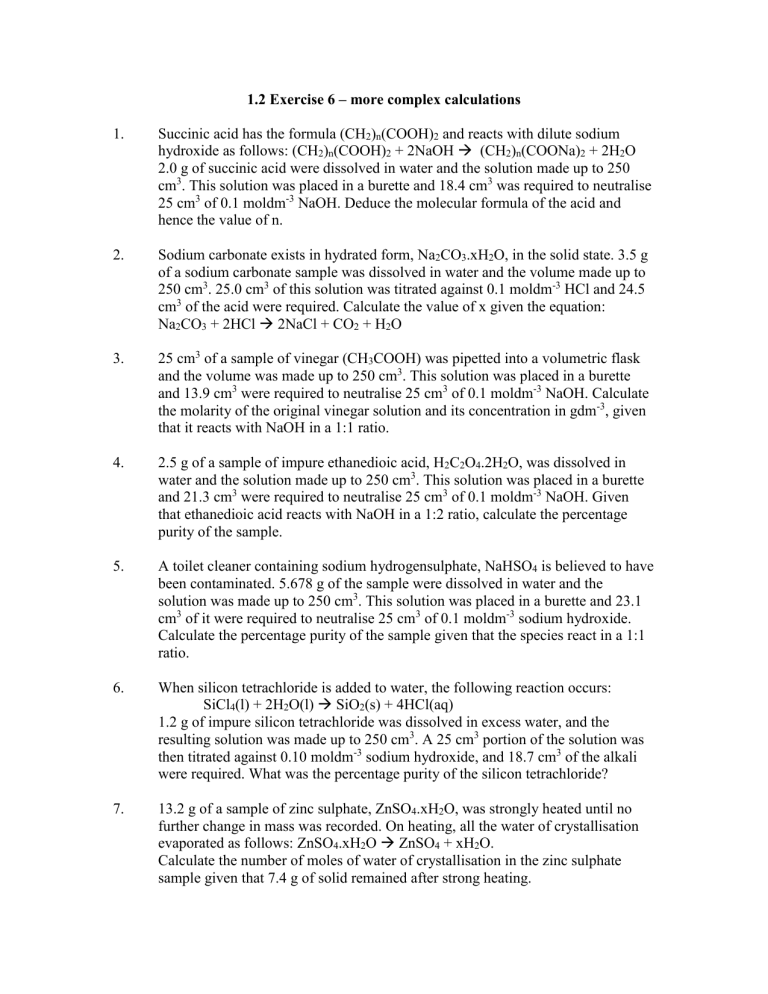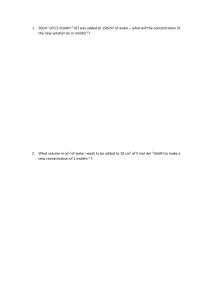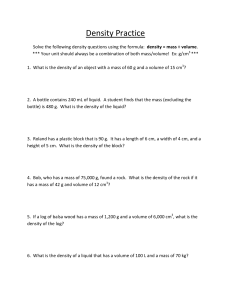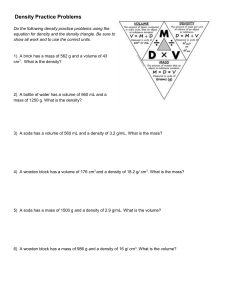
1.2 Exercise 6 – more complex calculations 1. Succinic acid has the formula (CH2)n(COOH)2 and reacts with dilute sodium hydroxide as follows: (CH2)n(COOH)2 + 2NaOH (CH2)n(COONa)2 + 2H2O 2.0 g of succinic acid were dissolved in water and the solution made up to 250 cm3. This solution was placed in a burette and 18.4 cm3 was required to neutralise 25 cm3 of 0.1 moldm-3 NaOH. Deduce the molecular formula of the acid and hence the value of n. 2. Sodium carbonate exists in hydrated form, Na2CO3.xH2O, in the solid state. 3.5 g of a sodium carbonate sample was dissolved in water and the volume made up to 250 cm3. 25.0 cm3 of this solution was titrated against 0.1 moldm-3 HCl and 24.5 cm3 of the acid were required. Calculate the value of x given the equation: Na2CO3 + 2HCl 2NaCl + CO2 + H2O 3. 25 cm3 of a sample of vinegar (CH3COOH) was pipetted into a volumetric flask and the volume was made up to 250 cm3. This solution was placed in a burette and 13.9 cm3 were required to neutralise 25 cm3 of 0.1 moldm-3 NaOH. Calculate the molarity of the original vinegar solution and its concentration in gdm-3, given that it reacts with NaOH in a 1:1 ratio. 4. 2.5 g of a sample of impure ethanedioic acid, H2C2O4.2H2O, was dissolved in water and the solution made up to 250 cm3. This solution was placed in a burette and 21.3 cm3 were required to neutralise 25 cm3 of 0.1 moldm-3 NaOH. Given that ethanedioic acid reacts with NaOH in a 1:2 ratio, calculate the percentage purity of the sample. 5. A toilet cleaner containing sodium hydrogensulphate, NaHSO4 is believed to have been contaminated. 5.678 g of the sample were dissolved in water and the solution was made up to 250 cm3. This solution was placed in a burette and 23.1 cm3 of it were required to neutralise 25 cm3 of 0.1 moldm-3 sodium hydroxide. Calculate the percentage purity of the sample given that the species react in a 1:1 ratio. 6. When silicon tetrachloride is added to water, the following reaction occurs: SiCl4(l) + 2H2O(l) SiO2(s) + 4HCl(aq) 1.2 g of impure silicon tetrachloride was dissolved in excess water, and the resulting solution was made up to 250 cm3. A 25 cm3 portion of the solution was then titrated against 0.10 moldm-3 sodium hydroxide, and 18.7 cm3 of the alkali were required. What was the percentage purity of the silicon tetrachloride? 7. 13.2 g of a sample of zinc sulphate, ZnSO4.xH2O, was strongly heated until no further change in mass was recorded. On heating, all the water of crystallisation evaporated as follows: ZnSO4.xH2O ZnSO4 + xH2O. Calculate the number of moles of water of crystallisation in the zinc sulphate sample given that 7.4 g of solid remained after strong heating.






